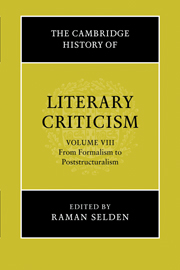Book contents
- Frontmatter
- Introduction
- 1 Russian Formalism
- STRUCTURALISM: ITS RISE, INFLUENCE AND AFTERMATH
- 2 Structuralism of the Prague School
- 3 The linguistic model and its applications
- 4 Semiotics
- 5 Narratology
- 6 Roland Barthes
- 7 Deconstruction
- 8 Structuralist and poststructuralist psychoanalytic and Marxist theories
- READER-ORIENTED THEORIES OF INTERPRETATION
- Bibliography
- Index
- References
3 - The linguistic model and its applications
from STRUCTURALISM: ITS RISE, INFLUENCE AND AFTERMATH
Published online by Cambridge University Press: 28 March 2008
- Frontmatter
- Introduction
- 1 Russian Formalism
- STRUCTURALISM: ITS RISE, INFLUENCE AND AFTERMATH
- 2 Structuralism of the Prague School
- 3 The linguistic model and its applications
- 4 Semiotics
- 5 Narratology
- 6 Roland Barthes
- 7 Deconstruction
- 8 Structuralist and poststructuralist psychoanalytic and Marxist theories
- READER-ORIENTED THEORIES OF INTERPRETATION
- Bibliography
- Index
- References
Summary
The Saussurean model
The small number of students who, in the years 1906–7, 1908–9, and 1910–11, attended the lectures on general linguistics given at the University of Geneva by Ferdinand de Saussure could scarcely have guessed that they were participating in the birth of one of the new century's most potent intellectual movements. Those lectures, recreated after Saussure's death in 1913 by Charles Bally and Albert Sechehaye from students’ notes and published as the Cours de linguistique générale (Course in General Linguistics) in 1916, produced two great waves of influence, the first upon the fledgling discipline of scientific linguistics itself, the second – after a delay of several decades – on the wider study of cultural practices and concepts. It is the second, the movement known as ‘structuralism’, which constitutes a major development in twentieth-century literary studies, but in order to explain the impact of Saussure's linguistic model upon this field (as well as upon a number of other fields, including anthropology, psychoanalysis, cultural history, and political theory), it is necessary to devote some attention to the most important elements of that model, and to the later modifications it underwent within linguistic theory. The development of the model within literary studies is largely covered in other chapters in this volume and in volume 9, and this chapter will offer only a sketch – with the exception of the work of Roman Jakobson, who occupies a unique position at the juncture of linguistic and literary studies.
- Type
- Chapter
- Information
- The Cambridge History of Literary Criticism , pp. 58 - 84Publisher: Cambridge University PressPrint publication year: 1995
References
- 2
- Cited by

